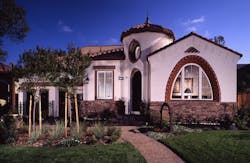Builders are mostly confident that newer codes are making the structural survivability of houses after natural disasters more viable. “There’s no reason not to build if you’re above the flood plain,” says Scott Frankel, co-president and principal of Frankel Building Group, in Houston.
Besides, many homeowners don’t want to leave where they live, despite future risk. Dan Freeman, owner of Lenox Homes, in Lafayette, Calif., says the residents there have strong roots in the community that have translated into their willingness to rebuild.
Robert Carroll, owner of Carroll Construction, in Clinton, La., says many homeowners in Baton Rouge who got washed out by the 2016 flood have come back, although he’s also seen some house flipping and a shift to rentals.
Homeowners returning after disasters have struck their communities must be patient, as rebuilding can be arduous. In October of 2019, a Bay Area television station reported that just 10% of the homes burned by fires in Santa Rosa had been rebuilt.
Code Changes and Complications
Consider Siena at Tuscany, a California neighborhood nearly wiped out by the Tubbs Fire. Homeowners who wanted to rebuild connected with Christopherson Builders, a local Santa Rosa builder, which in turn contacted Dahlin Group Architecture Planning, which designed some of the original homes at Tuscany in 2004.
But things had changed in the 13 years since, and some homeowners found they didn’t have enough insurance money to rebuild, while a prevalence of downsloping lots complicated the design process and raised costs. “Right off the bat, you’re into a more complex foundation,” says architect Donald Ruthroff, a principal at Dahlin Group.
While insurance will take building codes and new regulations into account, he says, costs for materials and local labor have increased at breakneck speed, to the point where Ruthroff estimates baseline rebuilding costs at $500 per square foot. One bright spot: If Ruthroff’s design for a new home stays within the original home’s footprint, the project can go directly to permitting, bypassing extra planning review.
Synergy Group by Christopherson, which the owners of Christopherson Builders launched in 2014 to focus on rebuilding after the Tubbs Fire, offers 15 house plans, plus different interior/exterior options. As of early October 2019, it had rebuilt 60 homes in the Coffey Park neighborhood, with 40 more under reconstruction, says Synergy’s co-owner and partner Brian Flahavan.
Another wrinkle: Unlike standard on-your-lot projects, there’s a far stronger emotional component to deal with. “I say this to every client,” Ruthroff says, “‘I know this isn’t what you wanted to do this year. You probably never planned to build a house. But we’ll help you through the project so you can start again.’ That’s our beginning goal.”
More about resilient construction and home builders' efforts to build more resilient homes:
- The Need for Resilient Construction
- How One Prefab Building Company Is Rebuilding Better in the Face of Disaster
- Roadblocks to Resilient Construction After a Natural Disaster
- House Lift: Elevating Foundations as a Response to Flooding

